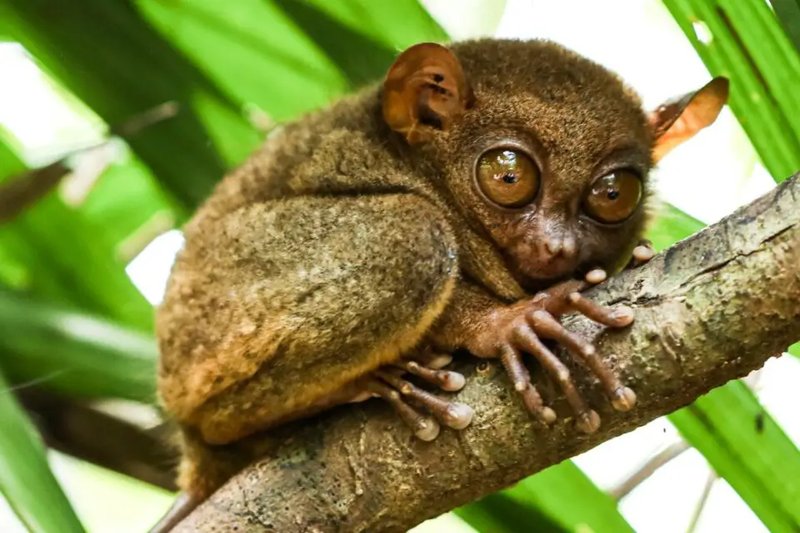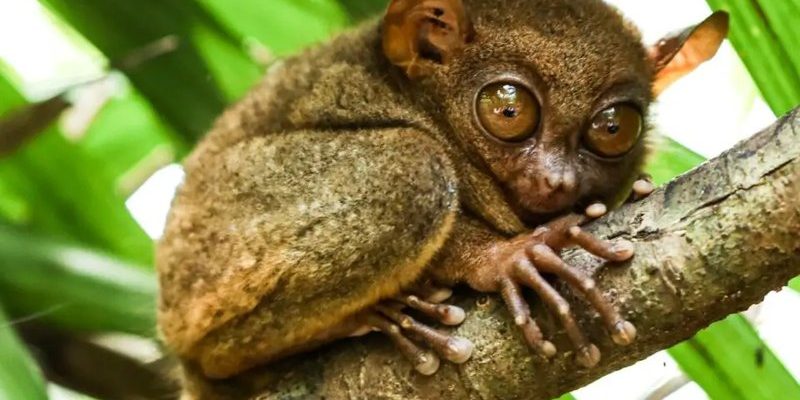
Understanding these animals can sharpen your wildlife knowledge and enhance your appreciation for biodiversity. So, let’s dive in and explore 10 animals that are similar to lemurs, highlighting the key characteristics that differentiate them. You might be surprised at the diversity out there!
1. Tarsiers: The Tiny Nighttime Primates
Tarsiers are like the little night owls of the primate world. Hailing from Southeast Asia, these tiny primates are known for their massive eyes, which help them see in the dark. Honestly, if lemurs are the playful clowns of the forest, tarsiers are the quiet, mysterious cousins who prefer to hang out in the shadows.
What sets tarsiers apart from lemurs is their size and dietary habits. Tarsiers are much smaller, usually around the size of a fist. While lemurs munch on fruits, leaves, and flowers, tarsiers are strict carnivores, snacking on insects, small birds, and even small mammals. So, if you’re ever privileged enough to spot one, you’ll notice the difference right away!
2. Galagos: The Agile Jumpers
If you’ve ever watched a lemur leap from tree to tree, you might be reminded of a galago, also known as a bushbaby. These adorable little primates are native to Africa and are famous for their remarkable jumping abilities. With their large eyes and long, bushy tails, they do have a lemur-like appearance, especially in their facial expressions.
One key difference is their behavior. Galagos are more nocturnal than lemurs and have a unique vocalization system that sounds like a baby crying—hence the name bushbaby! Their diet mainly consists of insects, fruits, and tree gums, letting them thrive in diverse environments.
3. Slow Lorises: The Toxic Cuties
Slow lorises are another intriguing animal that might remind you of lemurs. Their big, round eyes and small frames make them charming, but there’s a captivating twist: slow lorises are actually toxic! That’s right. They have a gland on their elbows that secretes venom, which they spread on their fur. While lemurs are playful and social, slow lorises prefer a more solitary lifestyle and are mainly active at night.
What makes them stand out is that they move rather slowly, unlike the agile lemurs. Those slow movements are a tactic to evade predators, adding an entirely different layer to their survival strategy.
4. Marmosets: The Tiny Acrobats
Marmosets are small monkeys that, like lemurs, are incredibly social and live in family groups. They’re native to South America and are known for their vibrant personalities. With their petite size and playful nature, marmosets have a similar charm to lemurs.
However, the differences pop up when you look closer. Marmosets have a diet heavily focused on insects, fruits, and tree sap, locking them into a very different ecological niche compared to lemurs, who enjoy a broader range of goodies. Plus, marmosets are more closely related to traditional monkeys than to lemurs, which are classified as prosimians.
5. Aye-Ayes: The Eccentric Night Watchers
The aye-aye is perhaps one of the strangest animals you’ll find on this list. Native to Madagascar like lemurs, aye-ayes have a unique way of finding food: they tap on trees to locate insects and then use their elongated middle finger to extract them. It’s like nature’s version of using a straw for getting the last drop of your favorite drink!
While they may look like a mix between a lemur and a rat, their feeding habits and long fingers set them apart. In fact, their very appearance has led to some misconceptions, often being labeled as omens of bad luck in local folklore.
6. Sifakas: The Graceful Leapers
Sifakas are another lemur relative that you must know about. Known for their graceful leaps and unique way of moving sideways, these primates are especially fascinating to watch. They have a similar body structure to lemurs, but their striking white and black fur often makes them stand out.
One distinguishing factor is their social structure. Sifakas tend to be more territorial than other lemurs, showing a complex social hierarchy. Their vocalizations are also more varied, which adds another layer to their community interactions. Observing a group of sifakas in the wild can provide a glimpse into their intricate relationships.
7. Indri: The Largest Living Lemur
The indri is the largest species of lemur, but it deserves a mention on this list because it’s quite different from its smaller relatives. Indris are known for their loud, haunting calls that echo through the forests of Madagascar. They have a distinctive appearance, with a fluffy body and short tail—quite unlike the long-tailed lemurs we think of.
One key difference lies in their lifestyle. Indris are primarily herbivores, munching on leaves and fruit, and they display strong pair bonds, often mating for life. This commitment to partnership is a striking contrast to the more fluid social structures seen in other lemur species.
8. Capuchin Monkeys: The Clever Tricksters
Capuchin monkeys are often seen in movies and TV shows, which makes them a familiar face among primates. Their intelligence is a notable feature that sets them apart from lemurs. Capuchins are about the size of a small cat and are highly social, living in groups with a well-defined hierarchy.
While both lemurs and capuchins are playful, capuchins are known for their manipulative antics—think of them as the pranksters of the primate world. Their adaptability means they can thrive in various environments, which is a real testament to their versatility.
9. Woolly Monkeys: The Tree-Dwelling Companions
Woolly monkeys are another South American primate that shares some characteristics with lemurs. With their long limbs and dense fur, they are built for life in the trees. Their playful demeanor and social nature make them charming companions in the wild.
However, woolly monkeys are larger and heavier compared to lemurs. They primarily eat fruits, nuts, and leaves, showcasing a broader dietary preference. Their social interactions are also different, as woolly monkeys tend to form stronger familial bonds within their groups.
10. Spider Monkeys: The Agile Swingers
Last but not least, spider monkeys are known for their incredible agility. With their long limbs and prehensile tails, they can swing deftly through the treetops. While they share some social behaviors with lemurs, such as living in groups, their physical build and lifestyle differ significantly.
Unlike the more grounded lemurs, spider monkeys thrive on fruit and occasionally eat leaves. Their lifestyle is more focused on foraging for food high up in the canopy, which starkly contrasts with lemurs that prefer a mix of ground and tree living.
Wrapping It Up
Exploring the animal kingdom can feel like wandering through a vast, colorful tapestry, where each creature adds its unique thread. While lemurs are undeniably captivating, there are numerous other animals with traits and behaviors that echo their charm. From the agile tarsiers to the strange aye-ayes, each animal brings its flavor to the table.
By understanding these fascinating creatures and how they differ from lemurs, you can deepen your appreciation for wildlife and the rich diversity that exists on our planet. So, whether you’re visiting a zoo, watching documentaries, or just chatting with friends over coffee, you’ll have these quirky facts up your sleeve. Next time someone mentions lemurs, you can dive into an exciting conversation about their awesome relatives!

